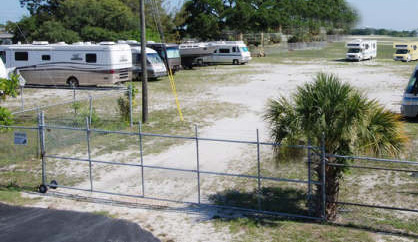
Overview Who Needs This? Excerpts Order Book Pictures Chapters
Answers Reviews Destinations Free Stuff More Contact Us
This page I wrote for my old rv website RVforSaleGuide.com before developing the Vanabode as the best travel vehicle for cheap easy long term road trips. People still like big rv's despite the much greater cost and trouble to operate, so here's what I know about them.
RV Storage
This RV Storage Guide helps you identify a good rv storage facility and prepare for storing your camper. RV storage issues are addressed here: choosing a facility, weather protection, insurance, and accessibility. If you are storing your motorhome in a cold climate for the winter you will find winterize your rv helpful as well. Visit RV spring startup for information on pulling it OUT of storage.
|
|
56% of those who store their rv keep their RV next to their house while 28% use public storage facilities. Only 4% have an RV garage for their RV. The average cost per month to store an rv outside is around $34 and most people live within 15 miles of where they store the motorhome. Inside covered storage with electricity available and sometimes air conditioned can cost $140 - $430 a month. Some campgrounds and rv dealerships also have affordable parking or rv storing facilities and rates.
When choosing a place to store the rv make sure you address cost, monthly or annual contracts, access hours to get into your rv, whether the site provides insurance of any kind while on their lot, taxes, security, and access to a manager or onsite person when needed. Some rv storage lots provide "winterization", battery charging, cleaning, period courtesy checks, etc.
Inside rv storage verses outside - outside storage is cheaper, otherwise if you can afford it store the rv inside, especially if you can do it in a controlled temperature environment. That means air-conditioned in the hot climates and heated in the cold climates. Inside rv storage like this eliminates the need for an expensive rv cover, tire covers, winterizing which takes a lot of time and planning, keeps animals and most bugs out, prevents all weather related damage like high winds, sun, and hail and rain, aging. They also tend to be more secure than outside rv storage places. Visit RV types for comparison of all motorhomes.
RV Refrigerator - while storing the rv for longer than 2 weeks, clean out the fridge and wipe the insides down with baking soda and water. Then leave an open box of baking soda inside fridge with door wedged open. If your refrigerator also runs off 12 bolt batteries make sure switch is OFF.
RV Exterior - breathable, polypropylene covers with zippered entry doors allow easy access to the interior of the rv if you plan to cover it. Covering the rv like this protects it from sun damage, acid rain, dirt, bird droppings, sap and more. Some covers resist water though they are NOT water proof. Actually they are designed to shed water like condensation, dew, or light rain but allow trapped moisture to evaporate. They do NOTHING in hard rain.
These covers are not without their problems though. One should be aware that certain animals and bugs find it quite comfortable under the covers as they appreciate the same protection you are trying to give your rv. Wind can be real problem as well. Strap and buckle attachment systems prevent billowing to a degree but be aware that ANY heavily repetitious movement could cause abrasion damage to weaker components like a plastic mirror casing or backup camera lens. If you buy an rv cover make sure the edges and seams are reinforced to prevent tearing especially over the ladder, and make sure you get an rv storage bag.
RV Tire covers - We just spent $1,447 having new tires put on our Class A rv. The bad thing was the tires we threw away had plenty of tread on them. However they were dry rotted from age and sun damage. Tire covers help prevent this and they are much cheaper than rv covers. Get the kind with bungee cord fasteners or good snaps so the wind doesn't tear them off. Heavy-duty flannel-backed vinyl reflects heat and light and repels liquids. To determine correct size, measure tire diameter from tread edge to tread edge, across center of wheel cover.
Batteries - remove your batteries when storing your rv by disconnecting the cables and removing the battery altogether. Store battery in a warmer part of your house but not inside where people sleep. If you are leaving them in the rv connect a smart battery charging system to them and leave connected to shore power when participating in rv storage. This article covers other aspects of storing your rv.


Home
Contact Us Copyright
© 2007-2016 Free
Guide They Hate Me
Privacy
Policy Terms
and Conditions Media
Press Affiliate
